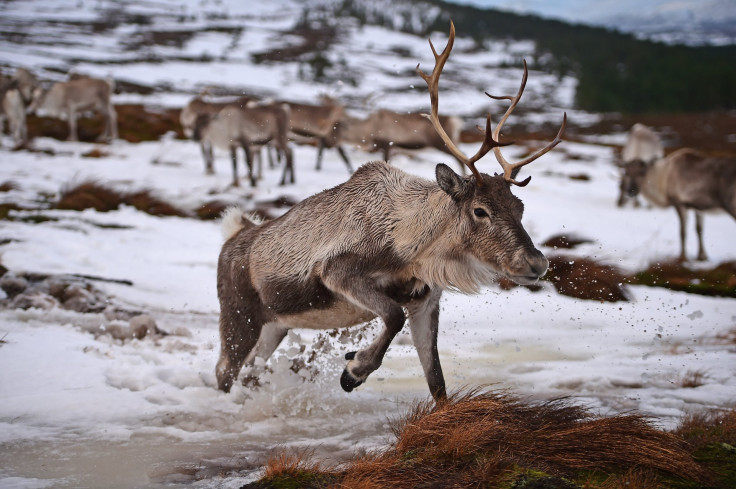Climate Change: Santa’s Iconic Reindeer Dying Of Starvation From Warming Temperatures

KEY POINTS
- The number of reindeer has dropped by more than half over the past 2 years
- Less tham 288,000 reindeer remain in Sweden.
- Only 10% of Sami people herd reindeer anymore
Reindeer, a beloved symbol of Christmas, are dying a slow death from starvation due to global warming in the Arctic.
In the northernmost reaches of Sweden, unusual weather patterns, including early autumn snowfall followed by freezing rain, have upended reindeer grazing activities with blocks of thick ice obstructing their pathways to food, notably lichen.
In Sweden’s Arctic zone, the indigenous Sami people have herded reindeer for centuries. But the ancient grazing territory of reindeer is already under threat by mining and timber industries. Now climate change poses a more dire threat to their livelihood.
“If we don’t find better areas for them where they can graze and find food, then the reindeers will starve to death,” said Niila Inga, a Sami herder.
Searching for food, the reindeer have migrated to areas where food is scarce or abound with natural predators (like wolves, bears and eagles) and dangerous avalanches. As they grow weaker, females often abort their calves. Adults struggle to survive.
“Extreme and strange weather is getting more and more normal,” Inga said. “We have winter here for eight months a year and when it starts in October with bad grazing conditions it won’t get any better.”
Data from the Swedish Meteorological and Hydrological Institute indicate Sweden as a whole has warmed up by 2.95 degrees Fahrenheit since the preindustrial era. In Sweden’s northern regions, where reindeer are found, average winter temperatures between 1991 and 2017 were 5.4 degrees Fahrenheit higher when compared to the 1961-90 average.
"There's so much snow now in the mountains, so the reindeer are coming down faster than we expected, so now there's a little bit of a panic to get them down," said Christer Johansson, a Sami herder. "They can't find any food up on the mountain, so they have to come down to the forest."
Even without the complication of global warming, most Sami have already abandoned reindeer herding. Of an estimated 70,000 Sami who live in northern Sweden, Norway, Finland and northwestern Russia, only about 10% still herd reindeer.
Sanna Vannar, the president of the Swedish Sami Youth organization, filed legal action in 2018 against the European Union to more aggressively cut greenhouse gas emissions. In early 2019, the European General Court rejected the case on procedural grounds.
“We’ve said we don’t want money because we can’t buy better weather with money,” Vannar said. “We need that the EU take action and they need to do it now.”
Tim Horstkotte, a post-doctoral researcher at the Swedish Agricultural University, said that one of the problems with climate change is its unpredictability.
“If you compare it to last year's effect, it's completely the opposite,” he said. “This is one of the other things that reindeer herders are quick to point out: that it becomes unstable and unreliable. It's impossible almost to plan ahead because things can change so dramatically in a short space of time."
Moreover, moving large herds of reindeer to grazing areas with sufficient food supplies is costly and cuts into the herders’ profits.
"[Herders] often point out that they are experts in survival and have been living in this landscape for centuries, so they are quite successful in adapting," Horstkotte said. "[But] their ability to do so comes at a certain financial cost."
Beyond these problems, herders receive low prices for reindeer meat and skins.
"Hardly anyone lives off this [herding profession]," said herder Johansson. "It's expensive. You need a snowmobile, a quad bike, that's [$15,941] easy. You need at least 2,000 or 3,000 reindeer to live off it."
In addition, most Sami reindeer herders have a side job to make ends meet – usually in tourism, fishing, crafts or other trades.
"If you see someone with an old snowmobile, and an old quad bike, then they might live from it. Everyone else has another job. It's more like a hobby," Johansson added.
There are now only 225,000 to 280,000 reindeer left in Sweden.
The number of reindeer across the globe has fallen by more than half over the past 20 years largely due to climate change.
"The fact that these herds are declining shouldn't be a shock -- they do it all the time," said Don Russell of the National Oceanic and Atmospheric Administration. "But they're at such low levels, you start to be concerned. If we return in 10 years and [their numbers] have gone down further, that would be unprecedented."
© Copyright IBTimes 2024. All rights reserved.




















